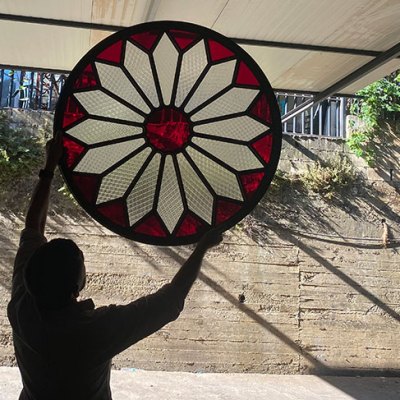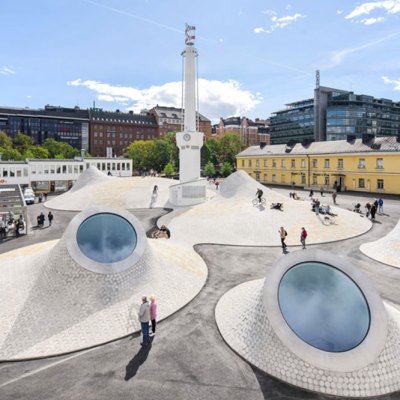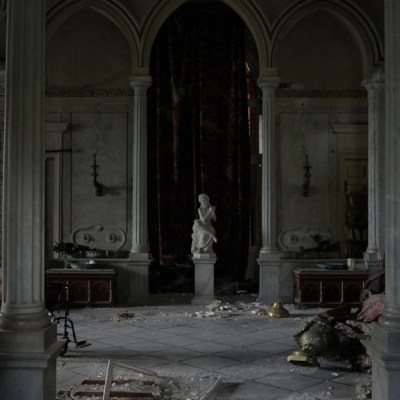In 1867, as the result of a treaty between France, Prussia and other European powers, the impregnable fortress surrounding Luxembourg City – the ‘Gibraltar of the North’ – was demilitarised. Certain sections of the complex of forts, ramparts and bastions, devised by the engineer the Marquis de Vauban, were blown up completely. Others, such as Fort Thüngen on the Kirchberg plateau, were decommissioned but preserved in form. Luxembourg, until then only nominally independent and perpetually garrisoned by foreign troops, became a neutral buffer state – and, ultimately, one of the world’s safest, richest countries. More than a century later, in 1989, the park abutting Fort Thüngen was chosen as the site for Mudam, the country’s flagship contemporary art museum. I.M. Pei’s design for the building appeared to spring forth from the vestiges of the fortifications, rhyming with the contours of the defunct strongpoints and towering over the last remains of Luxembourg’s militarised past. In its finished form, his Mudam was an emblematic construction of its time, a potent and elegant expression of the idea that, enabled by liberal democracy, art would always triumph over force.
In ‘A Model: Prelude’, his current exhibition at the museum, Rayyane Tabet takes a chainsaw to the consensus that permitted this kind of thinking, itself now as distant a memory as Francis Fukuyama’s ruminations on ‘the end of history’. The Lebanese artist has transformed part of Pei’s building into a chilly twilight zone, in which signifiers of domestic comfort become mechanisms of basic survival and the modernist utopianism of the architect’s vision is contorted into something altogether more uncertain. It is the best kind of site-specific art: a thoughtful, unsentimental meditation on the particularities of its host institution and a powerful retort to the well-meant but hubristic orthodoxy from which it sprang. Its resonances continue to ring in the ears long after you have walked through the exit.
View of Mudam, Luxembourg. Photo: © Studio Rémi Villaggi
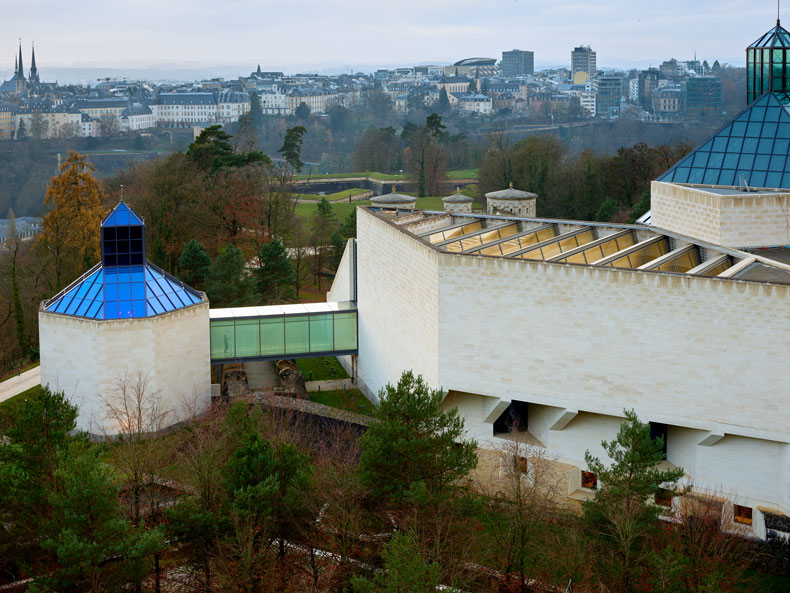
The project sees Tabet take over what was, perhaps, the most striking feature of Pei’s design: an octagonal, watchtower-like pavilion, illuminated by skylights and connected to the main structure by means of a glass walkway. Normally, that passage would give the visitor the impression of floating over the once-impassable fortress walls directly below, further emphasising the supremacy of the arts. Tabet, however, has compromised the effect by draping its plate glass walls with a set of white inner window blinds that once hung in his grandparents’ apartment in Beirut. The most rudimentary use of these swathes of synthetic fabric is to allow their owner a partial view from a window while preserving at least a modicum of privacy – in principle, a purpose not so different from that of a traditional mangour, a kind of perforated wooden window screen common throughout the Middle East. Yet once through the passage, the duality of concealment and visibility takes on a more sinister air.
Tabet has covered the skylights of Mudam’s pavilion with the kind of semi-transparent, deep-blue vinyl that Beirut’s beleaguered citizens routinely applied to the windows of their homes to conceal movement within during Israeli bombing raids. Tabet has used this gambit before – in last year’s exhibition ‘The Return’, at Beirut’s Sfeir-Semler Gallery, for instance, or in his 2021 show at the Walker Art Center in Minneapolis – but here it is particularly successful, the atmosphere it creates as cold as Sergei Lavrov’s handshake: it takes a while to adjust the eyes to the mesmeric aquarium effect of the light. Mirroring the contours of the gallery is a room within a room, sections of its walls cut out to reveal a set of pristine Alvar Aalto furniture: a metal bed frame, an armchair, a closet, a lamp and a desk. All are magnificent pieces of design created for the tuberculosis sanatorium at Paimio in south-west Finland in the 1930s, a site conceived with the hope that architecture and design could, in themselves, play a significant part in the healing process. In this context, however, it takes on the air of a blast room, the kind of generic, windowless space apartment-dwellers are advised to shelter in at the first sign of aerial attack. Formal elegance, in this instance, becomes a redundant attribute.
Installation view of ‘A Model: Prelude’ by Rayyane Tabet at Mudam, Luxembourg. Photo: © Studio Rémi Villaggi
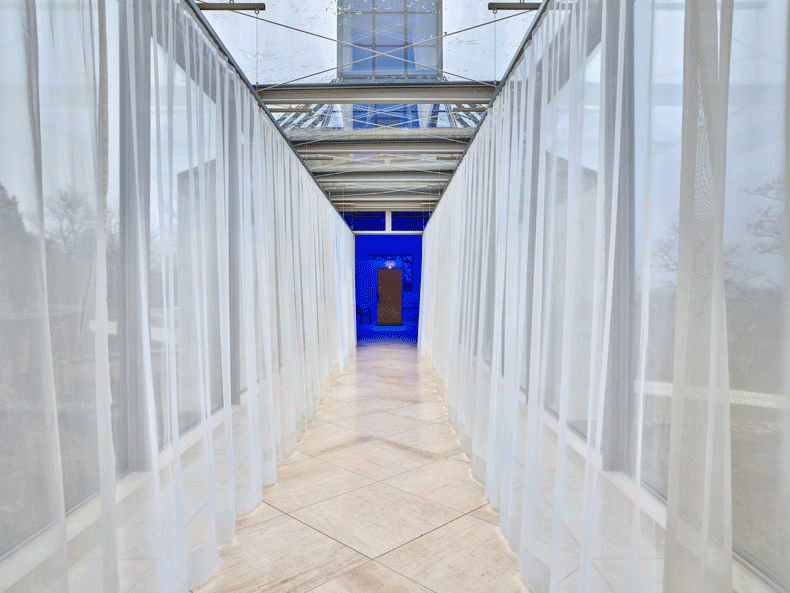
Over all of this hangs the spectre of a recent and indiscriminately lethal historical tragedy, in response to which no amount of DIY camouflage was ever going to be much use: the Beirut blast of August 2020. In the small basement space of the pavilion, Tabet has installed a custom-built rack of industrial shelving, each of its 200 display slots housing a formally identical ewer in frosty, blue-tinted glass. The display might put one in mind of Norman Foster’s postmodern strategy for the archaeological museum at Narbonne, in which local finds occupy endless racks of shelving similar to the sort of thing you might find at your local IKEA. But Tabet’s jugs are no antiquities; as stickers affixed to many of them attest, all have been fashioned from fragments of windows recovered from Beirut’s streets in the aftermath of the explosion.
Leaving Mudam, already a little shaken, I followed signs from the museum down to the Centre Ville on the other side of the canyon-like Pfaffenthal quarter. There is no indication whatsoever that the muddy path will lead you directly through the subterranean passages of the fortifications and, given the gradient, no easy way of turning back and heading for the tram stop. But it’s a fascinating, if claustrophobic, experience: for all of the panoramic paintings of fortified Luxembourg you might find at Versailles or in the Prado, you will never really get a sense of quite how ingenious, contingent and often elegant – indeed, in form almost modernist – Vauban’s designs are until you are lost inside them. Still thinking about the eerie gloaming of Tabet’s efforts just up-slope, I suspect that he must have identified something similar.
Installation view of ‘A Model: Prelude’ by Rayyane Tabet at Mudam, Luxembourg. Photo: © Studio Rémi Villaggi
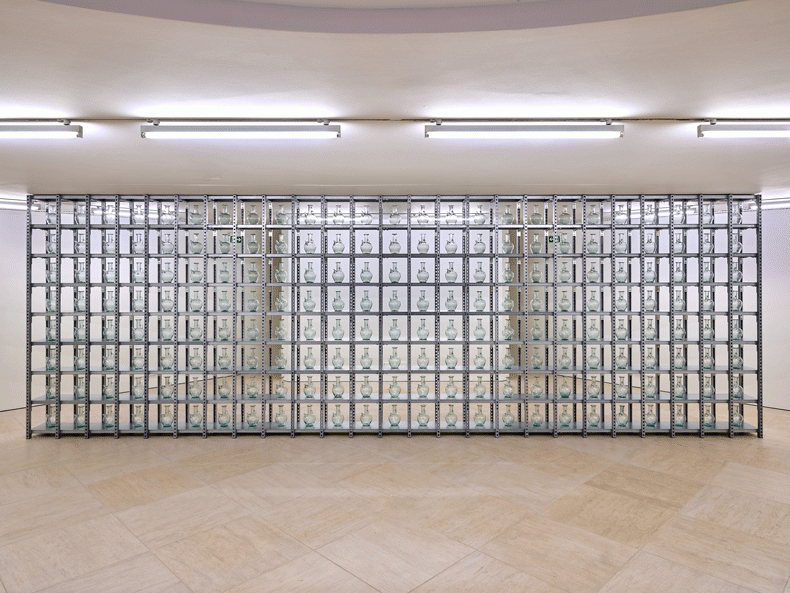
‘A Model: Prelude’ is at Mudam in Luxembourg until 12 May.

